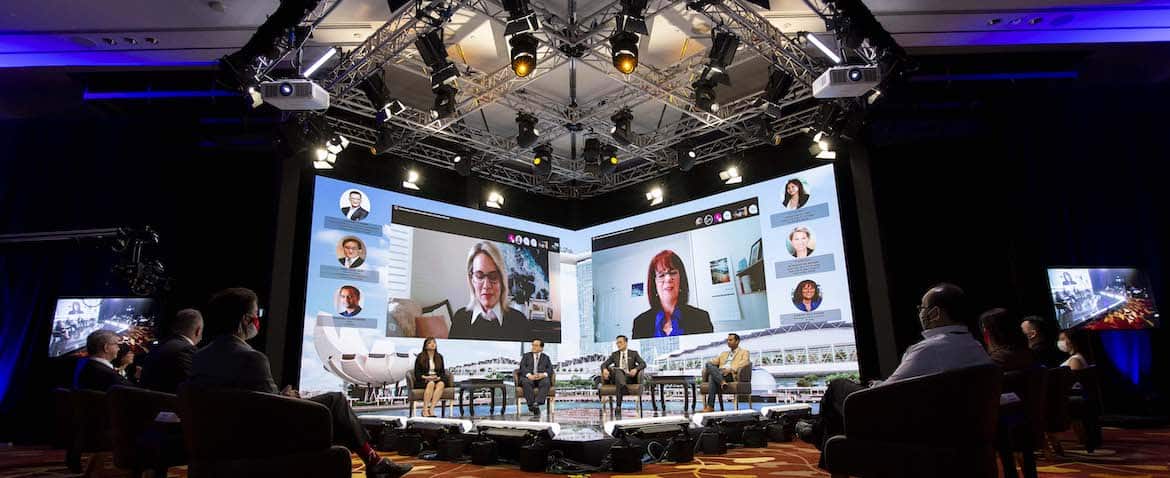The past couple years have certainly been an eye-opening experience for those planning and attending events. Online conferences, expos, meetings and other hybrid event experiences have been a great substitute, but many of us still miss the energy and interaction of an in-person event. On a positive note, we’ve also learned that although virtual events can’t always replace the real thing, they can still be highly effective.
The biggest cost for any in-person event is the staging itself, so hybrid events certainly help coordinators get more out of their investment. They have the opportunity to allow maximum reach and revenue potential by selling in-person tickets at one price and online tickets at a discounted rate. The extra revenue obtained from a bigger audience has the possibility to bring in more revenue simply by adding a virtual component. A virtual option also allows planners to collect valuable data that may not have been collected with an in-person only event, which can improve future events.
Attendees are also finding hybrid events more appealing as well. A larger group of people can engage in product opportunities and all the great content from presentations, also linking up with colleagues online without the time and cost of travel or the expense of full-price event tickets.
So the question is… how can you create successful events that engage all participants? Here are our top tips for keeping communication, collaboration and engagement flowing between online and in-person attendees:
1. planning
First question should be this: “What should the attendee experience to be like?” Next, you need to put yourself in the shoes of someone attending the same event in person versus online. What do you want this experience to look like for each of these attendees? What do virtual attendees miss out on? Narrowing down where these experiences differ is the first step to planning a successful hybrid event.
Then you must close the gap between the in-person and online experience. Almost 75% of event planners got more familiar using technology during the pandemic, and those new skills should be put to good use during your hybrid event. As an example, setting up a wall of monitors displaying the faces of online attendees during networking events helps them feel more present in a session and makes it easier for remote attendees to ask questions during Q&A sessions. Providing the opportunity to walk up to these screens and converse directly and organically with the person on the other end is something attendees will not forge. These thoughtful touches do take time to organize, so it’s important that you start planning early.
2. content
People who attend your events online may be paying less for admission, but make sure they still feel like they’re getting their money’s worth. Try offering an interactive element—something that makes online attendees feel like they’re active participants in the event. Quizzes and polls are two ways to get people involved, along with creating breakout sessions between online and in-person attendees. Just be sure to keep them small enough so that everyone can share their thoughts and have quality discussions.
Remember this: content must easily interact with the technology you use. For instance, Zoom calls are great for conversation among participants, but you can’t easily play a video in a Zoom call, and online attendees could feel like they’re missing out. These wrinkles should be ironed out prior to the event ensure the content comes across in the best way for all attendees, no matter their location.
3. engagement
Hybrid events have the capability to be a valuable experience for all, but does require some extra accommodations when it comes to virtual participants. For them to feel actively engaged and not sitting on the sidelines, try to bring incorporate these digital guests into the physical space of the live event. Q&A sessions are a great example. Instead of simply reading an online attendees question to the in-person audience, put their face on a large screen so they can ask it themselves. It’s important to note, people go to events to be seen and heard, so make sure virtual attendees have the opportunity to interact as well.
Even something as simple as mailing a welcome kit or swag bag that ties in with the event to remote participants’ homes can make them feel like a more equal part of the show.
BOTTOM LINE
The key to making hybrid events attractive and a long term part of your marketing strategy will be finding creative ways to make them engaging for all attendees. When conditions allow, we have no doubt in-person events will return in full swing—but that doesn’t mean you’ll see virtual or hybrid events will disappear completely. Trade shows that incorporate in-person and online components are the future.
If hybrid events factor into your marketing strategy, the right mix of planning, technology and outreach makes these events superior to anything that came before. And for the simple fact that more people can get involved, they’re the common goal for event planners and attendees alike.


